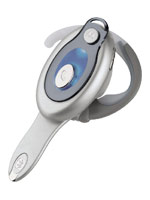I’d like to officially declare that wearable computers have hit the mainstream.
When I started wearing a hat-mounted display connected to a 50 MHz shoulder-strap Linux box back in 1996, I defined a wearable computer as having five features: portable while operational, supporting of hands-free use, equipped with sensors into the environment, ability to be proactive in supplying information or aid to the wearer, and always on, always running. When sponsors or journalists would look at my contraption and ask how such a beast could ever become mainstream I’d just point to their cellphones, which strictly by my definition were already wearable computers and which were becoming more wearable-like all the time.
 |
Motorola HS810
Wireless Headset |
The thing that made cellphones only borderline wearables was that they’d usually be in a pocket or bag rather than worn — that meant their access-time was greater than that critical one or two seconds that make wearables so compelling. With bluetooth phones and the most recent round of wireless headsets I think there’s finally been a shift in how non-researcher, non-techies are using cellphones, and it looks a lot like what we self-described cyborgs were doing a decade ago.
I first started noticing about six months ago that people around my lab were wearing these bluetooth headsets even when not talking on the phone. These weren’t just researchers, these were the venture capitalists and financial planners that occupy the rest of our building. Then a few days ago I landed in the Atlanta airport and noticed not one but three people turn on their bluetooth-enabled cellphones, put on an ear clip and then not talk on the phone. These were early adopters but not techies, and yet they looked just as fashionable and comfortable wearing their headsets as they did in their expensive suits. I talked to two of them about their new fashion accessory, and both gave the same explanation: it’s now so comfortable and so simple that they prefer to wear the headset just in case a call comes in. The woman I talked to said it was just more convenient to wear the device than find a place to carry it, and now she never had to go hunting for her cellphone when she got a call. It was so light and comfortable, she said, that she soon just forgot it was there altogether. The man talked about what a pain it used to be to be carrying suitcases on the escalator when the phone rang, and how now he just pushes the button on his ear and starts to talk. He also showed off the hands-free dialing feature: just tap your ear and say “office” and the phone’s speech recognition system automatically connects you.
This sort of technology has been creeping up on us for years, so it’s easy to miss the progress. It’s nice to take a step back and see how seamlessly these people integrate with their technology compared to when I was “packing iron” on a daily basis. In many ways, they’re far more cyborg than I ever was.


